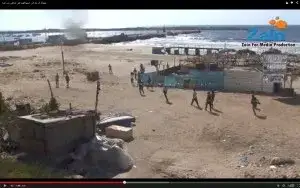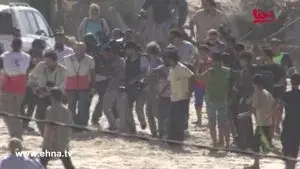Haaretz confirms Hamas deception operation
April 12, 2024 by Thomas Wictor
Today I was going to write a post about the journalists who witnessed the events on the Gaza beach, July 16, 2014. My contention is that the killing of Ismail, Mohammed, Ahed, and Zakaria Bakr was part of an elaborate Hamas deception operation designed to portray Israel as a nation of child-killers. Two days ago a journalist phoned me and said that I was correct. This person told me that I had missed the only facet of the incident that mattered: Reporters would not have immediately run to the scene of the explosions unless they had permission and unless they knew it was safe to do so.
Many people have contacted me, asking either for the journalist’s name or for me to send messages to the person. I promised the person that I would never reveal the person’s name, and I have no way of contacting the person. The conversation lasted about five minutes, and I didn’t ask for a phone number or e-mail address. This was a one-time occurrence. I’m positive that I won’t hear from the person again.
However, in doing research for what I’d planned to post today, I just found an article that confirms everything the journalist told me. It’s a Haaretz piece titled “Foreign press: Hamas didn’t censor us in Gaza, they were nowhere to be found,” by Anshel Pfeffer. The subheadline is “Reporters who covered Operation Protective Edge in Gaza dismiss Israeli accusations of giving Hamas an easy ride.”
I think it’s absolutely fantastic that this deeply dishonest hit piece on Prime Minister Netanyahu provides the final proof that the murders of the Bakr boys were part of a Hamas deception operation. Haaretz spoke to foreign reporters—who asked for anonymity, just like the journalist who contacted me. Most of the reporters scoffed at the notion that Hamas controlled their reporting. In the process of unloading on Netanyahu, they corroborated everything said by the journalist who called me.
On Wednesday night Benjamin Netanyahu briefed the foreign press, summing up four weeks of warfare in Gaza. “Now that the members of the press are leaving Gaza and are no longer subjected to Hamas restrictions and intimidation,” he said, “I expect we will see even more documentation of Hamas terrorists hiding behind the civilian population, exploiting civilian targets. I think it’s very important for the truth to come out.”
Netanyahu’s expectations have yet to be fulfilled. Of the 710 foreign journalists who crossed into Gaza during Operation Protective Edge, only a handful have claimed they were intimidated by Hamas or produced hitherto unpublished footage of rockets being fired from civilian areas, such as the pictures filmed by Indian channel NDTV, which were shown at the Netanyahu briefing. Maybe such footage will still emerge — all the foreign correspondents interviewed for this piece insisted that it doesn’t exist, and not because they wouldn’t have liked to obtain such pictures.
Here’s a screen grab from the NDTV footage they’re talking about.
What happened next was that a bunch of arrogant drunks got liquored up and spilled the beans to Haaretz.
Foreign Ministry spokesman Yigal Palmor says he can’t believe “how veteran war photographers couldn’t capture even one launch team, a single Hamas fighter on a barricade, the kind of exclusive photo they routinely risk their neck for.”
“What nonsense,” says one senior correspondent based in Israel. “The fact that NDTV succeeded proves nothing; it was an almost unbelievable opportunity. There are places which are just too dangerous and a photographer has to first protect himself.”
See? Exactly what the journalist who contacted me said. Reporters have to protect themselves first. At the beach in Gaza, they’d just heard two massive explosions, the cause of which they claimed to not know, yet they ran to the scene—according to Palestinian witnesses—in two minutes.
“There are always some gung-ho photojournalists who would go to any front line, no matter how dangerous,” says Anne Barnard, the New York Times Beirut bureau chief, who spent two weeks reporting from Gaza. “But that requires essentially an informal embed with the militants, to even be able to locate them without getting caught in crossfire on the way.”
Perfect! I appreciate that, Anne. Right from the mouth of the New York Times. Journalists need an informal embed with the terrorists in order to keep from getting caught in the crossfire.
Supposedly the Israeli Navy was shelling the beach. Despite the obvious danger, the reporters ran right to the target, not worried in the slightest about a crossfire.
“I described the few Hamas fighters I saw in my pieces,” says one veteran war reporter, “but there were so few of them. It reminded me a lot of Lebanon in 2006, where you didn’t really see Hezbollah fighters even right at the border. Except for one chance encounter with a mortar team who looked embarrassed to be spotted. It was the same in Iraq, too, in the 2003 insurgency. Most of the time the fighters were invisible and dangerous.”
Precisely! The IDF was attacking a site that may have been crawling with dangerous, desperate, angry, fanatical, ruthless Hamas terrorists, but the reporters ran to it. No hesitation whatsoever.
“You could understand why [the terrorists] stayed out of sight: Israel appeared to be defining Hamas targets very broadly, to include any member of the Hamas administered police, government, etc. They may have felt that they would be targets, and so would the reporters they were talking to. We certainly were concerned about that ourselves.”
But you certainly weren’t concerned about yourselves when you ran to the beach.
How did you know that the IDF wouldn’t shell you or shoot a Hellfire or drop a 2000-lb bomb on you? Did someone assure you that you’d be safe?
“There’s been a lot of talk about Hamas preventing us from seeing them,” says another correspondent with extensive experience in covering Middle East wars. “But the fact is that the areas they were fighting in were just too dangerous. If I had tried to report from Shujaiyeh during the fighting, I would probably have got killed. Hamas isn’t a regular army: When they leave the fighting areas, they don’t wear uniforms or carry guns.”
BUT YOU RAN RIGHT ONTO A BATTLEFIELD! IT’S NEVER HAPPENED BEFORE! A thundering herd of reporters ignored their decades’ worth of experience and their survival instincts and sprinted toward what they should’ve considered deadly danger.
“In all conflicts, reporters are loath to ‘serve’ either side by revealing information that could lead to a specific strike in real time,” says the New York Times’s Barnard. “Even information that could be seen as having led to a specific strike.
“First of all, that could endanger all reporters by making them be seen as spies. But beyond that, we are observers, not participants. We don’t want to be the reason that, say, a bomb was dropped. What if it killed a bystander? So let’s say I had seen a rocket launch from a specific building in Gaza, which I did not, I would not have reported it in real time, by my own choice. For one thing I wouldn’t want the return strike to come while I was standing there.”
None of that was applied to the Gaza beach incident. They ran to the target, reported live from the scene, and stood there without a care in the world. Some even removed their body armor.
And their helmets.
You don’t need to know the identity of the journalist who contacted me. Haaretz and every reporter to whom they spoke has confirmed that Ismail, Mohammed, Ahed, and Zakaria Bakr were murdered by Hamas in order to carry out a deception operation.
This article viewed 702 times.








